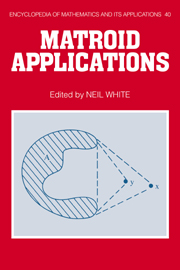Book contents
- Frontmatter
- Contents
- List of Contributors
- Preface
- 1 Matroids and Rigid Structures
- 2 Perfect Matroid Designs
- 3 Infinite Matroids
- 4 Matroidal Families of Graphs
- 5 Algebraic Aspects of Partition Lattices
- 6 The Tutte Polynomial and Its Applications
- 7 Homology and Shellability of Matroids and Geometric Lattices
- 8 Introduction to Greedoids
- Index
8 - Introduction to Greedoids
Published online by Cambridge University Press: 19 March 2010
- Frontmatter
- Contents
- List of Contributors
- Preface
- 1 Matroids and Rigid Structures
- 2 Perfect Matroid Designs
- 3 Infinite Matroids
- 4 Matroidal Families of Graphs
- 5 Algebraic Aspects of Partition Lattices
- 6 The Tutte Polynomial and Its Applications
- 7 Homology and Shellability of Matroids and Geometric Lattices
- 8 Introduction to Greedoids
- Index
Summary
Introduction
Greedoids were invented around 1980 by B. Korte and L. Lovász. Originally, the main motivation for proposing this generalization of the matroid concept came from combinatorial optimization. Korte and Lovász had observed that the optimality of a ‘greedy’ algorithm could in several instances be traced back to an underlying combinatorial structure that was not a matroid – but (as they named it) a ‘greedoid’. In subsequent research greedoids have been shown to be interesting also from various non-algorithmic points of view.
The basic distinction between greedoids and matroids is that greedoids are modeled on the algorithmic construction of certain sets, which means that the ordering of elements in a set plays an important role. Viewing such ordered sets as words, and the collection of words as a formal language, we arrive at the general definition of a greedoid as a finite language that is closed under the operation of taking initial substrings and satisfies a matroid-type exchange axiom. It is a pleasant feature that greedoids can also be characterized in terms of set systems (the unordered version), but the language formulation (the ordered version) seems more fundamental.
Consider, for instance, the algorithmic construction of a spanning tree in a connected graph. Two simple strategies are: (1) pick one edge at a time, making sure that the current edge does not form a circuit with those already chosen; (2) pick one edge at a time, starting at some given node, so that the current edge connects a visited node with an unvisited node.
- Type
- Chapter
- Information
- Matroid Applications , pp. 284 - 357Publisher: Cambridge University PressPrint publication year: 1992
- 26
- Cited by

